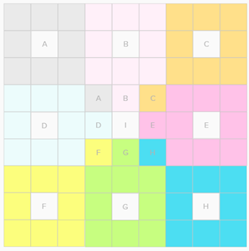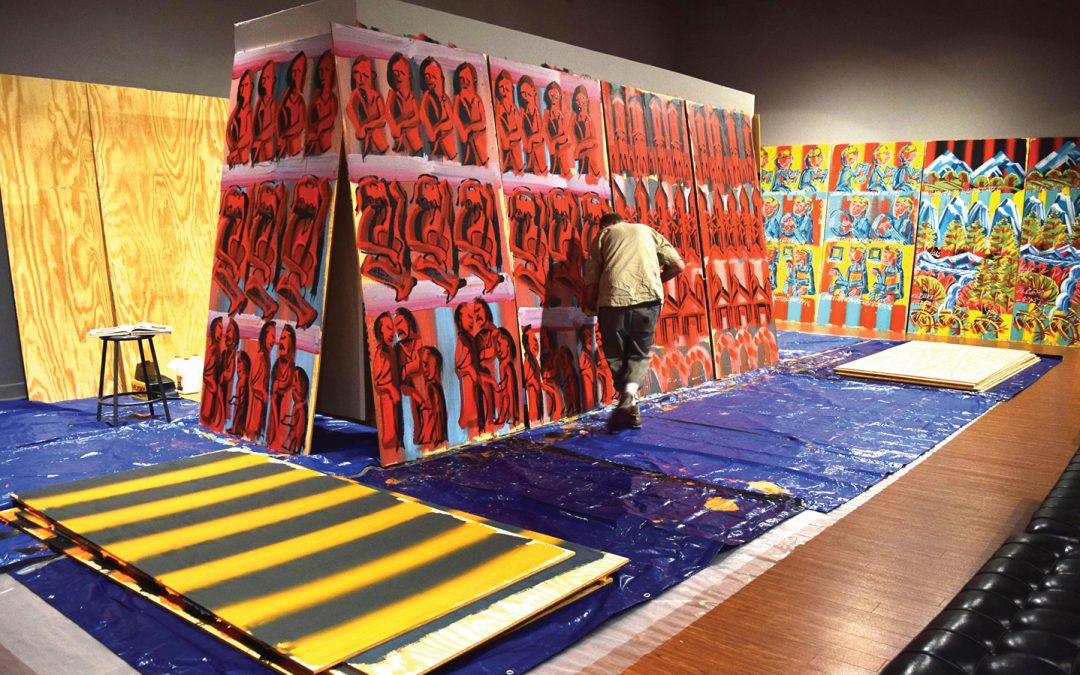by dbward | Jun 28, 2024 | Uncategorized
The Irish poet & author John O’Donohue wrote a beautiful book titled To Bless The Space Between Us. One of my favorite bit in the book is titled A Friendship Blessing, which includes these words:
May you be blessed with good friends.
May you learn to be a good friend to yourself.
May you be able to journey to that place in your soul where there is great love, warmth, feeling, and forgiveness.
May this change you.
That last line really hits me – the way friendships change us in positive ways. I’ve been co-teaching a series of courses lately (with the friend who gave me O’Donohue’s book!) and it’s got me thinking a lot about the concept of change and how that is one of the main goals of education & training. As we introduce new concepts and lead exercises, in the back of my mind I find myself thinking “may this change you” (and reflecting on the ways it’s changed me!).
If the classes and conversations don’t change us, then they’re just an amusement. I like amusements, but we are aiming for something more significant than that. We’re looking to make some change. And by “change” I don’t mean picking up a new technique or applying a new tool. I’m talking about something more foundational. ITK training aims to move us all towards a more open, iterative, experimental, collaborative, playful, curious way of working. It aims to move people away from an individualistic, perfectionist, control-oriented pursuit of certainty, predictability, and power.
That kind of change doesn’t happen overnight. It doesn’t happen in a classroom. It takes time and deliberate effort to establish and sustain this way of working out in the world. And it also DOES happen in a moment, when we decide to go in this direction. Or maybe it happens in a hundred moments, as we keep deciding and taking action.
I hope this ITK project sparks real change in all the people we touch. I hope it brings the blessing of good friends doing good work together, in ways that changes us and the world around us.

by jstarling | Dec 19, 2023 | Uncategorized |
This week’s blog post is by Joanne Moore
As we close out 2023 and look forward to 2024, all sorts of media are providing a look back. Even my smartphone somehow generates a slideshow of pictures from the year. Funnily enough, some of those pictures capture awkward moments that I didn’t curate out of my files. We learn so much by spending a little time reflecting on what’s happened and what lies ahead.
In the same way, we learn quite a bit by conducting a retrospective exercise for our work—whether at the end of a project, or at some other milestone point. The beauty of a retrospective is the ability to provide thoughtful, critical and constructive feedback so we can learn and grow from the experience. The most common innovation tool to conduct a simple retrospective is called “rose, bud, thorn” (RBT) and asks what went well, what are the possibilities, and what are the pain points. The RBT framework is time-tested, but sometimes it can spark controversy or be off-putting for some participants.
I recently had several opportunities to use an alternative to RBT that asks participants to complete sentences beginning with “I like, I wish, and I wonder.” This means of providing feedback tended to avoid assigning blame with “you” statements and concentrated instead on how the individual providing the feedback felt about the issue at hand. For example, “You were having meetings without including me” became “I like to be invited to all the meetings please”, and “This activity did not go well became “I wish this activity had gone better.” The I wonder statements ask about possibilities, turning “we should do it that way next time” into “I wonder if it would be better to try it that way”.
These statements provided outlets for how people felt, how they would have rather seen the situation handled, and for what could work as a different approach. Thus, these questions arrive at the same outcome—a constructive list of what went well, what are the pain points, and what are the possibilities for the future. So next time your team is ready for a retrospective, try these three questions to get inclusive, constructive responses from the entire team.

by dbward | Sep 11, 2023 | Uncategorized
This week’s blog post is by Starling Jaquan. Illustration by Francis Cleetus
You are starting off on a new project with your team. The air is filled with excitement and anticipation. Each member brings a unique set of skills and perspectives to the table, so you might wonder how to foster team morale, ensure everyone is on the same page, and build a shared understanding that fuels our collective success?
A team collaboration plan is a powerful tool to pave the way for effective collaboration. It outlines the strategies for working together to achieve your collective goals.
Without a well-defined structure even the most talented teams can struggle to align their efforts. A team collaboration plan is a roadmap that guides your team to a shared destination. Each member’s aspirations and expertise are acknowledged, so everyone’s contributions are valued. Collaboration is a delicate dance, and sometimes disagreements emerge. Conflict is inevitable, and a collaboration plan establishes a process for approaching conflict constructively.
How to Approach Creating a Team Collaboration Plan
The whole team should be in the room when creating the plan, so that everyone’s input is heard and included. Making a team collaboration plan is not just about drafting a document, it’s about fostering a sense of ownership among team members. At every step along the way allow for team members to vocalize their thoughts on the following topics.
1: Team Goals
What do you aim to achieve as a team? In this crucial step collectively define your team’s overarching objectives. Be specific and make sure that everyone is on the same page.
2: Individual Goals
How does everyone envision growing, learning, and contributing? Allow each team member to express their personal goals for the project. This step promotes transparency and helps align individual aspirations with the team’s mission.
3: Success
What does success look like for everyone involved? Collectively envision what achievement looks like for your project. Allow everyone to think about this holistically and consider what success looks like as both a team and individually.
4: Communication Channels
When might it be more appropriate to send a message over Microsoft teams versus an email? Discuss and decide how the team will communicate. Define preferred communication channels, expected response times, and related responsibilities.
5: Conflict Resolution
What does a successful conflict resolution look like? Anticipate conflicts and outline a strategy for resolving them. Establish a process for addressing disagreements and ensure that everyone is commitment to respectful communication, even in challenging situations.
6: Accountability Mechanisms
How will the team track progress to ensure that tasks are completed and that deadlines are met? Discuss how the team might develop a system for holding each other accountable. Accountability keeps the team on track and motivated.
7: Formalize the Collaboration Plan
Draft the plan and send it to the team for review. Make sure the plan includes everything the team discussed and agreed on. Encourage open feedback and adjustments as needed. Once everyone is on board, make sure the final version is accessible for all team members.
A team collaboration plan is a living document, as the project evolves revisit and revise the collaboration plan periodically. Remember, a collaboration plan is designed to empower not constrain. The plan is a tool to guide the team, not a rigid set of rules.
The next time you have a team that is starting on a new project consider creating a team collaboration plan. A team collaboration plan acts a roadmap to ensure everyone is headed in the same direction while fostering a positive and productive team environment.

by dbward | Aug 21, 2023 | Uncategorized
Today’s blog post is by Liz Roberts. Image courtesy of Palle1958 on Pixabay
I am always amazed when I see beautiful flowers grow in unexpected places, such as a city sidewalk. How is it getting enough sunlight? How has no one stepped on it? How did the seed get here? I recently had several experiences that reminded of these amazing flowers as I witnessed surprising ideas bloom during Lotus Blossom experiences.

Lotus Blossom – each colored 3×3 square is a blossom with a theme in the middle, each individual square in a petal storing an idea.
What is the Lotus Blossom Exercise?
The Lotus Blossom is an exercise that encourages idea creation. The structure consists of a standard combination of eight blossoms, or themes, where each blossom has eight petals or ideas. Although it is usually done in a group, it can also be just as effective when done individually. There is also no strict limit to the number of ideas generated and you should feel comfortable expanding beyond the original design. Because I am a Sudoku fanatic, the layout of the Lotus Blossom board always reminded me of the 9 x 9 zone-within-a-zone design in a Sudoku puzzle.
So back to the flower.
New Flowers in a Familiar Field
There I was, facilitating a Lotus Blossom exercise to help colleagues become familiar with the core competences needed for a leadership position. I used the leadership competencies, which I have become comfortable with over the past years, as the blossoms. I did the exercise with two distinct groups of participants, and I went into the activity expecting to see familiar ideas. I was blown away by the number of new, fresh ideas that I saw on the blossom petals. In some cases, I saw the competencies in new ways. I also realized that some impressive ideas did not fit into any competency but were amazing and should be demonstrated by leaders. I saw new flowers blossom in a field that I thought I knew so well.
New Flowers Spread Seeds
A few weeks later, I decided to use the Lotus Blossom again for a different event focused on brainstorming ideas on learning and career growth. I prepopulated the themes based on eight broad categories for how MITRE colleagues typically learn and grow. As the participants were adding ideas, I noticed one of the blossoms getting full, so I mentioned that they can add more petals in the white space right beyond the original eight petals. They surpassed the original goal of eight ideas by five additional new ideas! Here is what surprised me though – it was for on-the-job training. I wrongly assumed that blossom would have the fewest ideas. During our discussion, we all agreed that this was very exciting since on-the-job is where our staff spend most of their time. It was encouraging to see so many creative ways to take advantage of this training opportunity. We ended up with an actionable list to share with our staff on ways they can immediately start infusing training into their day-to-day job. This blossom might result in our staff blossoming in their own careers.
Encouraging New Ideas
During the Lotus Blossom exercise, here are some phrases you might try to nurture innovative ideas:
- “If you think it, ink it” to encourage people to capture their own ides in their own words.
- “Who have we not heard from?” to encourage quieter participants to join the conversation and share their ideas and can serve as a gentle signal to dominant voices to step back for a moment and make room for others.
- “Yes, and…” to enable candidness, which unlocks openings for key insights. The phase also enables creativity, which widens the aperture for what is possible and expands thinking in new ways previously blocked. To learn more about this powerful phrase, read the ITK Blog on What is ‘Yes, And…’?! and 7 Tips to Practice ‘Yes, And…’ During Everyday Collaboration.
If you have not tried a Lotus Blossom exercise, I recommend looking into it and seeing how you can help new ideas bloom for you and your teams.

by dbward | Apr 24, 2023 | Uncategorized |
This week’s blog post is by Patty McDermott
I’m lucky enough to have learned PreMortem from its creator, Gary Klein… twice!
Twenty years ago as a new college graduate in an exciting project kickoff, I remember diligently taking notes when the company owner, Gary Klein, took the meeting in a new direction. He described a future in which the project failed and asked us to come up with reasons for the failure. I felt pressure to say something insightful to show that I belonged in that conference room. The project details are long forgotten but I remember Gary’s approach getting everyone talking and bringing us together as a team.
Fast forward two decades. Gary Klein was teaching a PreMortem Masterclass at the 2022 Naturalistic Decision Making Conference in Orlando, and I jumped at the chance to participate.
Like a true mastermind trainer, Gary demonstrated his point in the Masterclass so naturally that we didn’t even realize it was part of the lesson. Gary gave us some time to review the workshop agenda before asking if the audience had any questions or comments about the plan.
Silence.
I will admit that I noticed some oddities in the order of events but passed it off as, “Gary must have a reason.” Gary then asked if anyone had silently questioned the agenda in their head. Hands shot up, mine included. The audience noticed several things that could have impacted the understandability of the class. Yet none of us said a word when asked. As Gary summarized, “People don’t speak up when they have a chance. That is why we need a PreMortem.” Mind. Blown.
People hesitate to speak up and point out weaknesses for many reasons, ranging from social pressure, lack of time, to wanting to keep things harmonious. The power comes from turning the dynamic on its head – changing the mindset to focus on critical thinking. Tap into people’s desire to be insightful and show off their cleverness. I think back to that conference room at the start of my career and remember fizzing with excitement of sharing an idea that no one else had considered.
Since Gary created the PreMortem over 30 years ago, it has been adopted all around the world. Here at MITRE, the PreMortem is one of ITK’s most popular tools. To help you get the most of it, check out these six tips.
- The PreMortem can be done in less than 30 minutes. You don’t have to dedicate an entire hour to get impactful results.
- When setting up the exercise, be playful. Describe a scene in which you have a crystal ball. The crystal ball doesn’t lie! By looking into it, you know the [project/tool/event] failed. But it’s not a good enough crystal ball to show you why it failed. Perhaps you need to insert more money to see the reasons for the failure. The point is that you need the stakeholders in the room to fill in the blank and describe the reasons for the failure.
- Give participants two minutes to write reasons for the failure. Ask them to get specific: go beyond answers such as “budget, time, or management.”
- Choose someone to start and go around the room. Only accept new and different answers to keep things moving.
- Write answers in a consolidated list that everyone can see.
- Give participants two minutes to write answers to the query, “What can I do to reduce chance of a fiasco?”
At the end of the session, participants will have used their creativity to list potential reasons for failure. But don’t end on a note of doom and gloom! Getting participants to describe proactive ways to avoid failure will set them up for success. They will leave the session with tangible early warning cues that things may be in trouble. The team can also make choices early on to mitigate problems before they even have a chance to occur.
I hope these tips encourage you to incorporate the PreMortem in your repertoire and help you conduct an efficient and effective session!
(image developed using Midjourney)

by dbward | Jan 16, 2023 | Uncategorized
One of my most memorable ITK experiences in 2022 involved leading 70 people through a Mission Canvas exercise. We divided the team into ten groups of seven, which means over the course of the hour I got to see 10 Mission statements take shape, ten different descriptions of this team’s present activities. The participants were not only were exposed to a variety of perspectives, they also uncovered the things they all have in common. It was a great example of how ITK helps teams develop “clarity and consensus,” and a cool affirmation that such things can even be established with a really big group.
In addition to the ways this benefited the participants, this experience was transformative for me, in large part because i got to see so many things happening at once. One thing I discovered is that I don’t love some parts of our canvas. Little things that previously seemed like a minor quirk I could easily dismiss or work around now loomed large as an unavoidable flaw in the canvas. I hadn’t really noticed this before – and now I couldn’t miss it. So we’re gonna fix that canvas – watch for an updated version, coming (hopefully) soon!
This experience brings to mind an observation from prolific artist Steve Keene (his website says “Over 300,000 paintings sold or given away“). In an interview, he explained “I love the idea of doing sixty paintings a day, and finishing them, more than the idea of trying to make one that I think is perfect. The whole system is based on trying not to beat myself up.” Volume has a certain magic about it, creating a sense of freedom from perfectionism and enhancing our understanding of the work (and the tools themselves).
I find Keene’s approach fascinating and inspiring. I love his emphasis on doing the work, on experimenting and trying a bunch of things, rather than trying to get it absolutely correct on a single try. It’s a refreshing alternative to the self-defeating perfectionistic approach, which prevents progress and does not, in fact, produce high-quality outputs. You know what does lead to creative, high-quality work? Making 60 paintings a day, and not just learning from each one, but learning from them in aggregate.
My suggestion – don’t just do one ITK session or come up with a single idea. Do ten sessions. Do sixty. Do them back to back. Do them simultaneously. Do them with 70 people in the room at once. As the brilliant Stephanie Medicke observed a few years ago, “The most dangerous thing you can do is go with the only idea you have.” So try out some different ideas, by doing more than one thing… or by doing something more than once.
To be super clear, this isn’t about pursuing quantity over quality. That phrase drives me bonkers. Instead, this is about recognizing that ramping up the quantity of our output is a path to improving the quality of our output. Sort of a “practice makes perfect” thing… except perfect isn’t the goal either (but I digress).
Back to the point – when a few of us attended South By Southwest last March, we heard Jeremy Utley provide a great definition of creativity that ties this all together nicely: “Creativity is doing more than the first thing you think of.”
So if you want to be creative (and I bet you do), the secret just might be… to pump up the volume, increase your output by a factor of ten, and expand your participant list beyond the usual suspects. Let each individual effort be a little bit wrong… and when you put it all together, you just may find it’s very, very right.
(image credit: courtesy image from Fort Myers Florida Weekly)






